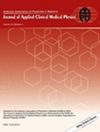Hounsfield Unit characterization and dose calculation on a C-arm linac with novel on-board cone-beam computed tomography feature and advanced reconstruction algorithms
Abstract
Purpose
Current cone-beam computed tomography (CBCT) on-board c-arm linear accelerators (linacs) lack CT number precision sufficient for dose calculation due to increased scatter from the cone geometry. This investigation evaluated CT number and dose calculation accuracy in-phantom on a novel on-board CBCT unit with potential for improved dose calculation accuracy.
Methods
Eight head and eight body configurations of an electron density phantom using 16 materials were acquired with a clinical CT-simulator(CT-sim) and novel on-board CBCT imager. CBCT projection data was reconstructed using conventional Feldkamp–Davis–Kress(FDK) and patient scatter-corrected iterative Acuros CTS with metal artifact reduction (Acuros-CTS-iCBCT-MAR) to create a robust CT number to physical density curve. CT-sim and CBCT images of anthropomorphic head and thorax phantoms were acquired, and three treatment plans were generated per phantom. All CBCT images were registered to the CT-sim of the phantoms, and the dose was recalculated on the CBCT images. 3D gamma analysis was performed (10% dose threshold, local, 1% dose difference, 1 or 2 mm distance to agreement), and dose–volume histogram (DVH) metrics were reported for target coverage and organ sparing.
Results
CT numbers for materials ≤1.08 g/cc showed high agreement between CT-sim and CBCT acquisitions. CT number precision improved with Acuros-CTS-iCBCT-MAR compared to FDK in all materials. High agreement between CT-sim and CBCT reconstructed with Acuros-CTS-iCBCT-MAR was observed in 3D gamma analysis showing 93.8% voxels passing in the worst case for a spine stereotactic body radiotherapy (SBRT) plan at 1%/1 mm. Maximum deviation in target coverage was −3.3% PTV-D98% in the lung SBRT plan among the novel reconstructed CBCT images. Plan comparison using FDK reconstructions yielded similar or worse agreement in 3D gamma analysis, with 69.7% voxels passing in the worst case for a spine SBRT treatment plan. Maximum target coverage deviation was −11.7% PTV-D98% among the FDK-reconstructed CBCT.
Conclusions
Novel CBCT solutions on c-arm linacs show promise for enabling direct-to-unit or offline adaptive dose calculation, potentially increasing versatility and efficiency of patient-centered care.





 求助内容:
求助内容: 应助结果提醒方式:
应助结果提醒方式:


